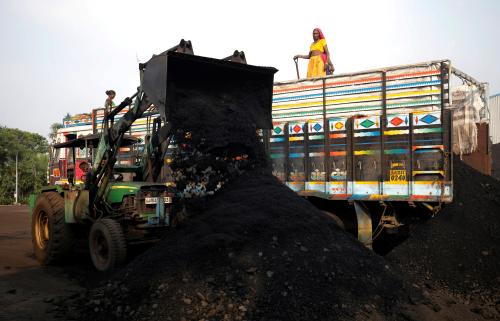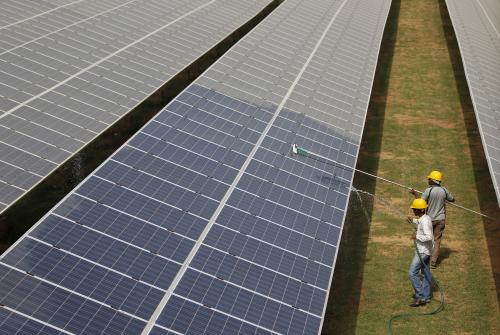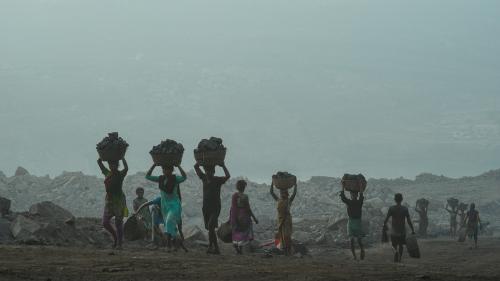Content from the Brookings Institution India Center is now archived. After seven years of an impactful partnership, as of September 11, 2020, Brookings India is now the Centre for Social and Economic Progress, an independent public policy institution based in India.
This article first appeared in Infraline Plus Magazine. The views are of the author(s).
The proposals for solving the current stranded capacity crisis should start a process of big picture thinking to achieve better collective outcomes on multiple long-term objectives. Doing so requires some decisive changes to the status-quo.
How we got here: The chronic factors behind recent woes
Contrast the following—energy and peak deficits are lower than 1% and 2% from over 10% less than a decade back, but thermal power plant load factors (PLFs) are down by almost 20% points.
For all its prospects, Renewable Energy (RE) is less than 10% of generation, so it cannot be blamed for the stranded thermal power assets that have mounted. In an effort to overcome the deficits, we have added much more thermal (coal) capacity over the last decade than what eventually was required. Results from CEA’s 19th EPS attest to the correction made to the over-projections of electricity demand from previous editions.
The situation in the last five years has been even more stark— thermal capacity addition has grown over 12% CAGR, generation over 9%, but end-use demand by less than two-thirds of the latter. Sure, the issues of water shortages, lack of fuel supply agreements, coal costs, availability and logistics, and DISCOM health are real and pressing, but the fundamentals remain. So the diagnosis of the current malaise needs to move past focusing just on immediate problems to more systemic issues. This is doubly important given the disproportional growth expected from RE in the coming years.
Will things get better: Systemic factors affecting thermal prospects
The future trends for total thermal generation rest upon three key factors:
- Competitiveness with and growth of RE: RE is already competitive with coal on a levelized cost (LCOE) basis and its costs will only fall further. In a few years, storage technologies will also be viable for making RE compete outside the solar hours round the year. On the other hand, the costs of coal generation, as discussed later, are set to increase.
- Technical losses in the system: Investment and policies towards reducing technical losses are already underway, which are likely to fall by almost a third of their current level by 2030, further suppressing generation requirement.
- Structure of economic growth and energy efficiency responsible for growth in end-use electricity demand: This author’s detailed bottom-up analysis shows that future growth (2015-30) will hover around 6.2%, down from 7% CAGR between 2000 and 2015, even with high growth in manufacturing.
Therefore, we must to come to terms with a lower future demand than previously planned for. Nevertheless, our analysis also shows that thermal power will continue to command a dominant share in electricity generation until 2030, unless the recent aspirations of 500 GW RE by 2028 actually materialize with requisite storage back-up. In such a case, we hit a situation where RE becomes the largest source, with coal following close behind. In most other scenarios, thermal power will constitute well over half of the total generation in 2030. Having said that, the planned capacities till 2022 are likely to suffice till 2030 if the PLFs and the viability of thermal industry as a whole are to be salvaged. Moreover, in this transitioning electricity sector, newer demands (or constraints) on coal-based generation have come up and existing ones intensified:
- Cleaner power: With 9 of the 10 most polluted cities, metropolitan urban air is largely unsafe throughout the year. Coal has its role to play, though more in the popular imagination than what source apportionment studies show (other reasons dominate urban air pollution). The air pollution norms will come to pass eventually, and so will the competition to do it at the cheapest. Studies suggest that compliance costs for MoEFCC’s pollution norms could raise coal’s variable costs by upwards of 20%.
- Energy Security: The issues with obtaining fuel supply agreements are well known to the industry, and also whether these contracts are honoured in terms of availability and fuel quality. On the latter, our analysis has shown wide variations between operational efficiency, coal quality trends, costs and output between different CIL subsidiaries. Further, the quality of CIL’s coal has been consistently falling (over 2% CAGR in the last five years)—a fact affirmed by the recent re-evaluation of mines and sidings by CIMFR.
This means that the cost per therm of average fuel supplied have been increasing—a metric of considerable interest to the industry. With renewed emphasis on energy security (import reduction) owing to exchange rate uncertainty and mounting imports, plants that may find it economical to import are restricted due to domestic fuel shortages or large distance from mines.
- Flexible Power: Since RE is growing and a must-run resource, coal is being increasingly looked upon to help manage variability by cycling, owing to the vast existing under-utilised capacity. This is by no means ideal— cycling adds to costs, leads to inefficient utilization, and reduces plant life. However, it presents a niche opportunity for certain plants that are unfit to compete for base-load generation. More on this later.
- Least-cost preference: The above demands go hand-in-hand with the demand for cost-effective thermal power to meet India’s developmental needs. As we move towards net electricity surplus, policymakers have changed their approach from adding more capacity to sorting between To this end, the CERC is exploring market frameworks for efficient dispatch to drive down costs to the true marginal cost.
So while generation from coal continues to grow (albeit at much slower rates from the past), the key question is how the existing and planned coal capacities will be reorganized along these multiple objectives.
Will the pains be equally shared: Structural factors behind winners and losers
Legacy issues dominate: All power plants are not born equal— issues of location and ownership matter a lot, and along with it the privileges. On average, central plants (with 10% higher PLF than others), get government coal linkages easier than private plants at cheaper transportation costs, and state plants are utilised more by state DISCOMs despite being relatively inefficient. Of the stressed assets in coal, most lie in the private domain and are without PPAs or FSAs, if not both. Among those that managed to obtain PPAs, some are facing financial stress owing to highly optimistic variable costs cited based on expectations that (as explained above) have not materialized. Pit head plants have much cheaper variable costs, but even here the private players with captive mines face an uncertain future with the cancellation of coal mining blocks a few years back.
Further, in this context of over-capacity and surplus, the costs and benefits of new and efficient technologies are under-appreciated, and so are the efforts towards effective pollution control and fly ash utilization. Energy markets could assure that the cheapest operational thermal plants get dispatched, but don’t necessarily guarantee they will be the best performing in terms of emissions or domestic coal input. With a focus on survival, we find that legacy issues dominate the winners and losers story.
Trade-offs can worsen collective outcomes: Is it then possible that frameworks designed around the multiple objectives of clean, secure, cheap and flexible power can neutralize these imbalances in thermal power plants to some extent? In an ideal world, competition between coal plants should help to meet all these objectives, even as some plants inevitably miss the bus. But it’s also clear that there are very real trade-offs— clean and/or flexible power will come at additional costs, and flexible thermal power due to technical reasons will be less clean and cheap than base-load power.
This is how it should play out:
- The cheapest among the cleanest and most efficient units form the baseload.
- The cheapest amongst the next best set of units perform the cycling and grid stability function.
- The remaining that could be cheaper than the above two categories but fail in terms of other objectives simply drop-out or join the ‘stand-by’ group.
But given how the current system and relationships are organized, there is no guarantee that this will materialize and the socially best outcomes are achieved. If the aforementioned inherent privileges are left unaddressed, they are likely to militate strongly against one or more of the objectives.
What needs to be done: A tiered multi-objective approach
The current malaise in the thermal power sector is multi-layered, and the short-term issues have complicated the picture. By only fixing the short term problems like auctioning of stranded capacity, the chronic, systemic and structural issues identified here will not be solved. There is no guarantee that a leaner thermal industry will also be efficient if we attempt a one size fits all approach. In other words, it is about satisficing your multiple objectives that attain the best overall outcomes, rather than merely focusing on one at the cost of the other. So the key stakeholders cannot afford to lose focus of the long view. Below are select few inter-related suggestions to help future planning around a tiered (based on matching needs with capabilities) and multi-objective approach (based on satisficing objectives).
- Sort capacity on the basis of function served: In a future high RE system, the role of and rules for base-load and cycling capacity must be differentially defined. The first step is appreciating the costs associated with each by valuing reserve capacity. These then need to be applied based on the appropriateness of different units to serve different functions. On their part, the thermal plants need to have a realistic assessment of their current state of operations and the function they are best suited to perform in the future grid. Under current framework, all are incentivsed to go after the most lucrative option, leading to a collective sub-optimality, akin to the Keynesian paradox of thrift.
- Target for achieving aggregate outcomes: Targets should be defined at the level of overall ambition considering trade-offs between objectives. For example, current pollution norms summarily target all capacity based on vintage. For plants that will only be called in for a fraction of their availability, the upgradation and retrofitting cost of some of these technologies will further add to the costs but reduce pollution to only a fraction of base-load plants. Instead, overall outcomes could be optimized with a focus on ensuring stricter standards and compliance on base-load plants, not to mention the ones located in disproportionately concentrated areas (i.e., the pithead).
- Overcome structural impediments: In the event that clean and efficient plants (e.g., supercritical) can simply not perform base-load function due to fundamental issues of lacking an FSA or being designed for imported coal, there is a double burden of ‘strandedness’ and collective inefficiency. If the goal of curbing coal imports has to be realised, not just the quantity but also the quality of coal needs improvement. For the latter, options such as washing coal must be taken up in earnest along with addressing bottlenecks to its utilization. On the buyers’ side, DISCOMs shouldn’t be buying more power from generators simply based on whom they can defer payments to easily, which are not necessarily based on marginal costs (let alone cleaner power).
- Reform through the value chain: As earlier argued, wholesale energy markets alone will not help meet the different objectives. These need to be accompanied by rationalization of fuel supply and logistics to generators, market design for power purchase that values multiple objectives, and inducing market responsive behaviour in the end-user. As an example of the latter, signals towards differential pricing of power at different times (peak vs off-peak) must be transmitted to the large consumers and urban apartment complexes. Not only will this help DISCOMs with managing time-of-day related uncertainties better than by simply shutting shop, but also signal market readiness for the electricity from flexible generators in short-term power markets.
To sum up, a horses for courses approach focused on aligning multiple-objectives should be followed. This cannot be done overnight, but is essentially a step-by-step process that starts from the lowest hanging fruits and eventually tackles the politically difficult choices. It is also one that requires inter-ministerial plus center-state coordination and compromise, and a space where regulators can play a facilitating role. The perception of fairness varies by industry and player, so the aim should be to achieve collectively superior outcomes.




Commentary
Op-edIndia needs to change the thermal power story to survival of the fittest, not luckiest
March 19, 2019